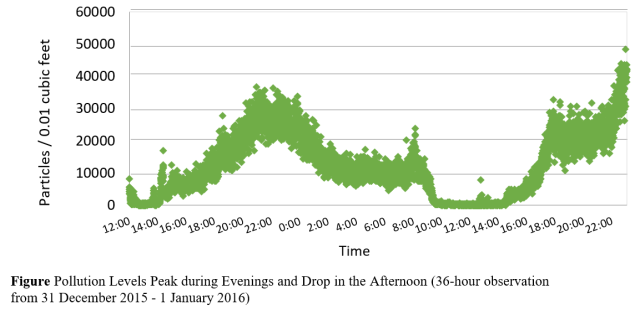Case Study of the Odd-Even Rule for Pollution Control in Delhi. Vikas Nath and Artash Nath. World Information Technology Forum (WITFOR). Costa Rica. September 2016.
 195 countries gathered in Paris for UN Climate Conference 2015 to conclude the legally binding climate agreement to reduce their greenhouse gas emissions. Continuous environment monitoring is a prerequisite for designing policies which can reduce global climate emissions. Only a handful of countries have the capabilities to carry out advanced climate measurements. Countries that do not have the capabilities to comprehensively monitor their national emissions are often the ones more severely affected by carbon emissions and with least capacity to adapt to climate changes. Commercial Off-the-Shelf (COTS) Technologies can lower the technological and financial barriers for developing countries to monitor climate emissions.
195 countries gathered in Paris for UN Climate Conference 2015 to conclude the legally binding climate agreement to reduce their greenhouse gas emissions. Continuous environment monitoring is a prerequisite for designing policies which can reduce global climate emissions. Only a handful of countries have the capabilities to carry out advanced climate measurements. Countries that do not have the capabilities to comprehensively monitor their national emissions are often the ones more severely affected by carbon emissions and with least capacity to adapt to climate changes. Commercial Off-the-Shelf (COTS) Technologies can lower the technological and financial barriers for developing countries to monitor climate emissions.
The authors made use of environmental commercial off-the-shelf (COTS) technologies along with information and communication technologies (ICT) to assess the impact of pollution control initiatives rolled out by the Delhi government on experimental basis.

As we are “makers” and love building things, we planned an experiment while the Odd-Even rule was in effect in Delhi. The objective of our experiment was threefold. First, measure the decrease in pollution levels while Odd-Even rule was in effect. Second, determine how pollution levels vary at different times of the day. Third, come up with findings to reduce the effect of pollution on our health.
We built a “Pollution Sensor” using COTS, namely a

Environmental COTS: Optical Dust Sensor
n Arduino – a low-cost, off-the shelf micro controller, and an Optical Dust Sensor (Shinyei PPD42NS) which is mass produced for measuring pollutants in the air. The Sensor uses infrared scattering to measure particulate matter concentration in the range of 2.5 microns – particles of this size have the greatest effect on human health. We wrote a program to get raw data from the sensor and convert it into particular matter readings (particles per 0.01 cubic feet). The program was uploaded to Arduino. The Arduino instructed the Optical Dust Sensor to take readings every 20 seconds and send it to our laptop. Later we added another low-cost COTS – a temperature and moisture sensor to our “Pollution Sensor” to take more detailed measurements. The data was imported into Excel to make graphs and draw conclusions.
Our experiment ran from 29 December 2015 to 7 January 2016. We even took the sensor high up in the air (in Spice Jet and Indigo airlines) to get cleaner air data for calibration. Observations taken ranged from 30 minutes to 30 hours continuously.
We did not observe any significant difference in pollution levels when the Odd-Even rule was in effect. In part because variables such as temperature, moisture, sunlight and wind speed change rapidly and measuring their collective impact on pollution level was beyond the scope of the experiment. We found that the particulate matter concentration decreases when temperature increases and increases when the moisture level in the air rises. This explains why pollution count is low in late mornings when the sun is out and the moisture levels are lower.

Mask Effect: Face masks can cut pollutants intake significantly
As climate change affects everyone, it opens up huge markets for products, technologies and services which can reduce the impact of climate change and allow people to lead better quality of lives. From farming to clean water, and from food supply chains to energy access, the start-up sector is growing – boosted by the interest and financing from angel investors and venture capitalists. Disposable pollution masks vending machines, wearables that repel pollutants, collar sensors that warn people when entering high pollution zones, and mobile air purifiers are COTS based products that are already in the market.
Access to environmental COTS such as sensors for measuring concentrations of carbon dioxide, nitrogen dioxide, methane, ozone and particulate matters in the atmosphere can improve and democratize environmental data collection. Virtually anyone would be able to purchase the sensors, hook them to a microcontroller and upload readily available programmes to start gathering local environmental data and share the date online. It will be possible to set up a mesh of sensors using COTS technologies such as WI-Fi, ZigBee, Bluetooth, and Radio Frequency (RF) that can communicate with each other to aggregate and triangulate the data being gathered. The low costs of new COTS such as drones and quad copters makes it possible to affix environmental sensors on them and fly them over highways, coastal areas, lakes and forested areas to get local but detailed data. Access to this 24/7 as well as on-demand data can reduce carbon emissions, check economic losses, improve public health, and allows governments and people to make more informed decisions.
For more information about the experiment and how to replicate it in other cities, write to Vikas Nath at vikas.nath@gmail.com or www.VikasNath.com
Complete paper published in ICT for Promoting Human Development and Protecting the Environment. 6th IFIP World Information Technology Forum, WITFOR 2016, San José, Costa Rica, September 12-14, 2016, Proceedings. Hardcover. http://www.springer.com/us/book/9783319444468
